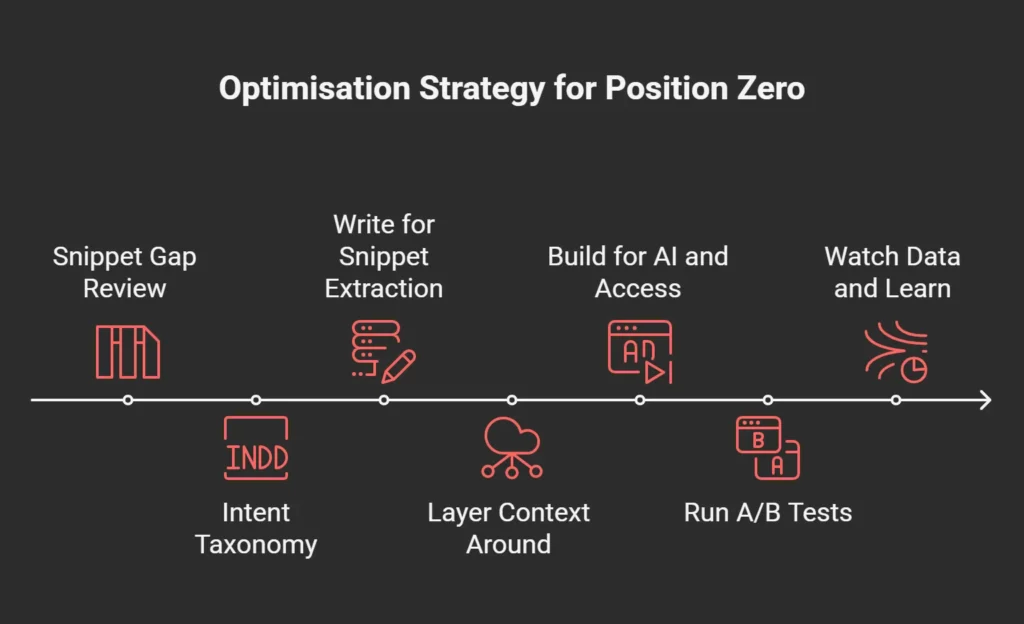The Evolution of Search and the Power of Position Zero
In a world where search engines now lead with AI, landing anywhere on the first screen of Google is only half the battle. The real treasure chest of traffic sits in Position Zero, that highlighted answer parked above the blue link sea. Because people now swipe to spoken answers and expect instant insight, mastering the art of snagging this top spot has turned into a must-have skill for brands and SEOs alike.

Search itself is changing at breakneck speed. As Google swaps keyword matching for meaning-hunting logic, and layers in the Search Generative Experience playbook have flipped. Featured snippets have become both navigation hubs and answer shelves, a fact underscored by research indicating that more than 35 percent of voice replies pull straight from these boxes (Backlinko, 2024).
In this blog, we unpack the modern anatomy of snippets, walk you through proven content tweaks, and flag the fresh metrics and tools you’ll need in 2025 if you want to claim and keep this prime digital real estate.
What are featured snippets-and why does position #0 still matter in 2025?
Featured snippets are curated search results that sit in a box at the very top of Google’s organic listings, giving users a fast, clear answer to what they asked. The answer might be a short paragraph, a numbered list, a table, an image, or even a video pulled from the most relevant page on the web.
Even with the growth of AI overviews and multi-modal SERPs, featured snippets still deliver distinctive advantages, including:
Types of snippets: paragraph, list, table, video, and entity cards.
- Brand visibility: landing at position #0 signals expertise and builds authority around a topic.
- Zero-click does not mean zero value: when users see your answer, they remember your name, trust your brand, and often follow that memory to a full site visit later.
- Voice search impact: Assistants like Google Assistant or Siri draw on snippets for their spoken replies.
A well-optimized snippet secures not only the spot but also a psychological lead, becoming the default answer lodged in the user’s mind.
The algorithmic psychology of featured snippets
Google’s ever-changing algorithm now prizes content that matches user intent, shows real expertise, and is laid out so readers can grasp it instantly.
– E-E-A-T + Google’s Search Generative Experience now determines which content earns a quick-answer box, pulling in material that feels rich, reliable, and highly relevant.
That means featured snippets appear or vanish on the fly as fresh articles arrive, searchers reformulate questions, or small signals such as scroll depth and click rate whisper to the algorithm.
Because Google’s engine recognizes the difference between What is? And how to? It crafts a distinct answer format for each. Authors who see this divide can match their style and structure to the query type most worth targeting.
To seize a snippet in 2025, write lines that please both the machine and the reader. Serving those twin masters remains the secret sauce.
Prerequisites Before You Optimize
Before you create content that chases featured snippets, check that your site’s underpinnings are solid:
- Crawlability & Site Architecture: Clear URLs, steady internal links, and a tidy page hierarchy help bots and readers discover every corner.
- Core Web Vitals: Fast loads, responsive interactivity, and stable visuals are especially crucial for mobile-first indexing and approval.
- Structured Data: Adding Schema.org labels such as FAQ, HowTo, or Speakable doesn’t guarantee a snippet, but it does explain the page to the crawler.
- Recency Signals: Fresh articles, visible update dates, and links to current trends matter most in fast-moving fields such as money, technology, and health.
- Content Identity Layer: Clarify who writes, who publishes, and who speaks on each subject in metadata and About pages. Google reads this context to judge trustworthiness.

Think of this task as tuning the engine before a big race. Without it, even winning prose may never cross the starting line.
Content Architecture: Designing for Snippet Selection
Once the groundwork is laid, the way you arrange your words starts to matter a great deal.
- Atomic Content Blocks: Split heavy subjects into short sections that answer a single question.
- Snippet Length: Aim for forty to fifty words in paragraph snippets; lists and tables may differ. Plainness and sharp wording win over length.
- Semantic Hierarchy: Mark questions with H2 or H3, then deliver a bold answer. Leave out chatter. Use markdown or bold for clear signals.
- Visual Aids: Icons in lists, ruled tables, and tidy graphs usually beat blocks of text.
- Annotated Value: State facts, sums, dates, or contrasts plainly. Hints and implications are often cut.
- Content Above the Fold: Put at least one snippet-ready block on the first screen. Early material usually gets first dibs.
Keep in mind that Google does more than copy text; it studies how tidy the layout is and how easily a mind can scan it.
Step-by-Step Optimisation Strategy for Claiming Position Zero
Step 1: Snippet Gap Review Run
Semrush Featured Snippet Reports or the SERP panel in Ahrefs to spot queries that land your page in the top ten yet deny it the featured spot.
Step 2: Intent Taxonomy
Classify each keyword by intent-Who, What, How, List, Compare-and match that label with the format your answer needs.
Step 3: Write for Snippet Extraction
Draft short, plain sentences; for How-to, use numbered points; for What-is, keep the reply to forty or fifty words.
Step 4: Layer Context Around
Surround the target answer with related terms and secondary keywords that give deeper meaning without cluttering the snipped block.
Step 5: Build for AI and Access
Mark up headings with HTML tags like or and supply alt text. Intelligent systems favour pages that everyone can read.
Step 6: Run A/B Tests
Switch headers, move the snippet, or rewrite key phrases; platforms such as SearchPilot let you field controlled SEO trials.
Step 7: Watch Data and Learn
Monitor clicks, impressions, and bounce rates in Google Search Console and pair those numbers with heatmaps to see where users scroll and what they tap.

Common Mistakes That Cost You Position Zero
Even well-meaning articles miss the mark. Here’s what to steer clear of:
- Buried Answers: If the key reply hides mid-page, Google probably skips it.
- Keyword Bloat: Snippets prefer streamlined sense, not a wall of terms.
- Format Mismatch: A paragraph looks weak when the result list shows a grid.
- Dwell Time: A long pause after users click the snippet suggests they found quality content.
- Brand Recall: Searches that repeat your name signal that trust and familiarity have taken root.
- Query Bounce Tracking: If users bounce back quickly, your page probably fell short of their intent.
Monitor results across channels. Snippet success stems from a tight partnership among SEO, UX, and writing.
Beyond Text: Multimedia and Entity Optimization for Snippets
Text alone no longer owns position zero. Here’s what is gaining ground:
- Video Snippets: Time-stamped tutorials backed by clear meta tags often appear for queries like how to install.
- Image Cards: Descriptive captions paired with rich images can land prominent visual slots.
- Entity Graphs: Content that relates to known entities ranks better. Boost relevance with schema and internal links.
- Multimedia Markup: Add VideoObject, ImageObject, and Speakable schemas whenever they fit.
- Voice Optimization: Snippets that serve as voice replies usually follow a neat Q-and-A style. Apply the Speakable schema and check results on smart speakers.
Final Thoughts: The Philosophical Value of Ranking #0
Featured snippets offer far more than a quick SEO trophy- they publicly signal that your brand communicates with both clarity and authority. In an Internet flooded with jargon and conflicting claims, Google uses the highlighted box to whisper, This source understands the question.
Landing at Position Zero quietly plants trust in the user’s mind. You are no longer just one option; you are framed as the answer. In 2025’s multi-modal search environment, that distinction acts like a protective moat.
So, do not chase snippets as a mere ego boost. Build resources that solve problems, serve users, and simplify complexity first. Visibility, reputation, and conversions will then follow as natural by-products.
Perfection is not the prize; clarity is. When you respect a visitor’s schedule, anticipate their queries, and deliver focused information without detours, you earn not only their loyalty but also their trust.
Bonus Section: 7 Tools to Help You Win Snippets in 2025

- SEOClarity Answer Box Analyzer: pinpoints snippet gaps and tracks how they perform.
- Frase.io: creates AI-powered briefs laser-focused on snippet-friendly wording.
- Outranking: merges SERP data with on-page advice for holistic guidance.
- Surfer SEO: aligns your sections, headers, and terms with top-ranking patterns.
- Keyword Insights: organizes intent-rich questions hidden within your keywords.
- Clearscope: deepens your entities and tightens their relevance.
- InLinks: wires a semantic internal linking web throughout your site.
Now, take a moment to examine your highest-ranking articles. Determine the precise question each one resolves. Next, recast that answer in forty to fifty words, enclose it with clear semantic cues, and enhance it through purposeful design.
Claiming position zero in 2025 is not a shortcut; it is a deliberate mindset.






